Being able to bring a guitar with you if you travel regularly is a big benefit. It allows you to keep your skills up while you’re away as well as relax at the end of a long day. If you travel for work, bringing a guitar with you gives you something to do while you’re in your hotel room.
In this guide, we’ll look at the different options you have for bringing a guitar with you while traveling. You’ll be able to find the right option for you as well as handy travel accessories to take with you.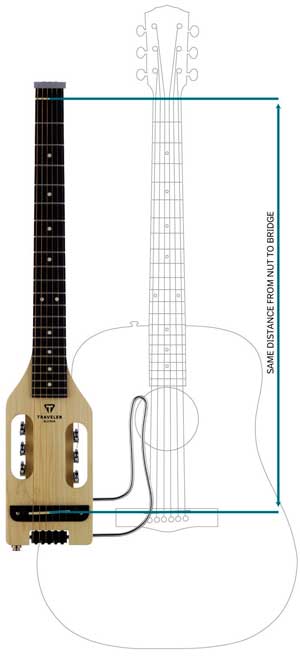
Travel Guitars vs Regular Guitars
One option is to bring your regular guitar with you. This might suit people who will be driving so can fit a full-size guitar in their car. Of course, you could take a full-size guitar with you when traveling by train or plane. The downside is the extra luggage cost, the possibility of damage, and hassle.
If you don’t like the idea of taking your regular guitars with you, the alternative is to buy a travel guitar. These guitars are designed for travel. They’re compact while still giving you the feel of a full-size guitar.
If you’re bringing your electric guitar with you, skip ahead to the travel accessories section. It gives you recommendations on gear to use instead of bringing your amp with you as well.
If you’re looking for a travel guitar because you have small hands, read through my guide to Guitar for Small Hands before you continue.
What to look for in a Travel Guitar
There are a few different options for types of travel guitars. You have a choice between electric or acoustic travel guitars, as well as a choice on portability.
Full-sized fretboard vs reduced size fretboard
Some travel guitars offer full-sized fretboards so it feels like a regular guitar (as shown to the right). By reducing the size of the guitar’s body, the fretboard can remain the same. The benefit here is that it feels like a normal guitar. This is a good option If you’re happy to sacrifice some portability so you can have a full-sized fretboard.
Some travel guitars use a smaller fretboard to help reduce the size of the guitar. These guitars feel very different than a regular guitar. Some guitarists are happy with these fretboards while others hate them. Try playing a 3/4 size guitar to get a feel for what it’s like playing on a smaller fretboard.
Volume
If you will be staying in a hotel, this is important to think about. Strumming away on an acoustic guitar at 3:00 am in a hotel room is likely to end up with an angry knock on your door. If you play an electric guitar or a silent acoustic guitar with headphones, you can strum as hard as you want without any problems.
There are silent options for both acoustic and electric guitars. These guitars are usually more portable than actual acoustic guitars so that’s an extra benefit.
Sound quality vs Portability
One of the reasons you don’t see performing musicians rocking out on stage with a travel guitar is they tend to produce an inferior quality tone. Take a look at the two guitars below and think about how different they’re likely to sound:
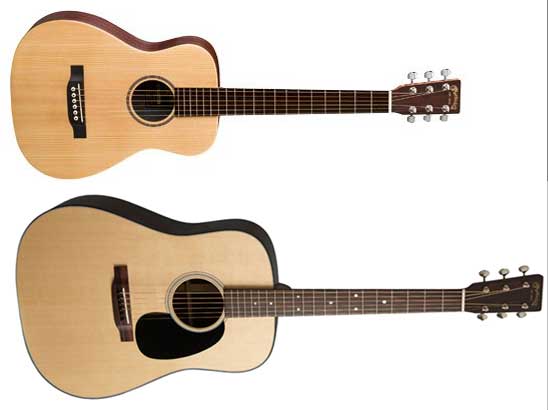
Advertisements claim that you don’t sacrifice any sound quality with these guitars. But there’s no way the above travel guitar’s small body can resonate as well as the full-sized acoustic. You don’t expect a ukulele to produce the same full tone as a full-sized guitar and it’s the same with travel guitars.
While there are a lot of acoustic travel guitars that do produce good quality tone, don’t expect amazing results. Your travel guitar likely won’t sound as good as your regular guitar and that’s okay. The goal here is to have a portable guitar that allows you to play while your away. So there’s nothing wrong with giving up some sound quality if it means you can take a guitar with you on your trip.
Acoustic vs Electric Travel Guitar
For some guitarists, this is an easy choice as you want to play the type of guitar you enjoy the most. If you only play electric guitar the choice is simple – get an electric travel guitar. You’ll be able to plug it into a mini-amp or headphones as you see fit.
If you play both electric and acoustic guitar, consider getting either an electric guitar with a piezo bridge if possible. This will give you a way to play silently while still hearing an acoustic tone.
If you play acoustic guitar, you have the hardest choice to make. You can buy a travel acoustic guitar so you have the look and feel of a regular acoustic guitar. The downside is you won’t be able to play in silence and it will be larger than the alternatives. Most acoustic travel guitars are around 30-40 in long ( 76-100cm). As you will see, this is significantly larger than many of the silent electric/acoustics you need to plug into headphones to hear. These guitars allow you to play in silence. They come at a smaller size but they don’t look or feel like an acoustic. So you need to decide what is more important to you.
Best Acoustic Travel Guitars
There are plenty of options for acoustic travel guitars. Instead of trying to list all them and pick out the ‘best’, I’ll give you three very different options so you can get a feel for what features are important to you.
Little Martin
The Little Martin series includes a few different models including an Ed Sheeran model. They’re 3/4 scale guitars with a 23″ scale neck. This is important to remember because you may or may not like the feel of a 3/4 scale guitar. When I pick one up, it feels like I’m playing a child’s guitar. For others, it might be a perfectly fine compromise when traveling.
Find out about Ed Sheeran’s signature Little Martin guitars in this guide on Ed Sheeran’s Guitar Rig.
Here are the main features of the Little Martin:
- 23″ scale length
- 34″ total length
- 12″ wide and 3″ deep body
- 20 frets
- Sitka spruce or mahogany body
- Micarta, rosewood or richlite fretboard
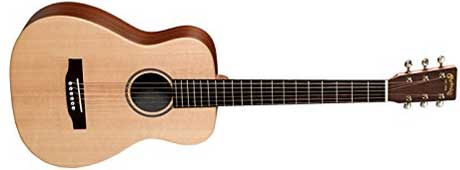
Cordoba Mini M Travel Acoustic
The Cordoba Mini M Travel Acoustic is is a very popular option for a few reasons. It’s almost half the price of the Little Martin above and smaller in size. At 30.5 in (77.5 cm) in length, it’s a very portable guitar. For many people, the lower price and smaller size are enough to choose the Cordoba. But an important difference that makes this guitar worth considering is it has a full-width fretboard.
Having a full-width fretboard means it will feel normal when you play chords. Your hand won’t cramp trying to squeeze into position like it might with other travel guitars. It will feel like a real guitar except for the tiny body size. For most players having a full-width fretboard is a far better option than having a scaled down fretboard that feels cramped to play.
Here are the main features of the Cordoba Mini M (check out the price and features here):
- 30.5″ total length
- Full-width fretboard and 20 1/8″ scale length
- 10″ wide and 3″ deep body
- 18 frets
- Solid spruce top and mahogany body
- Rosewood fretboard
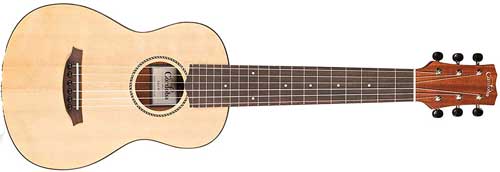
While the Little Martin may be higher quality than the Cordoba Mini, the smaller size and full-width fretboard make it a solid choice when traveling.
Voyage-Air Folding Acoustic
If you look at the lengths of the above travel guitars, they’re not that different to a full-sized guitar. Most of the reduction in size is from using a smaller body. For something different, the Voyage-Air series of guitars are full-sized guitars (one model is close to full size at 15/16). The big reason why this is a good travel guitar worth considering is that it has a folding neck.
There are a couple of advantages with this guitar. First, it’s a full-sized guitar. Once you set up the guitar it plays, feels, and sounds like a real guitar. If you don’t like the idea of playing something that looks and feels like a child’s guitar, this might be an option to consider.
Second, the collapsible neck means the guitar folds into a smaller length than all of the above travel guitars. When folded, the guitar’s length measures at 20 5/8 in (52 cm). That’s significantly smaller than the above travel guitars. The larger body does mean you have a bulkier bag, so you need to work out whether the difference works for you or not.
The first thought I had when researching this guitar was whether it is a pain to set up. The below video gives a good idea of what it’s like to pack up and set up the Voyage-Air:
It’s pretty impressive that it can hold it’s tune as well as shown in the above video. Even if it requires some minor tuning adjustment, it’s still a nice and easy setup process.
Here are the main features of the Voyage-Air:
- Full-size guitar (or 15/16 scale size)
- 20 5/8″ total length when folded
- 24.75″ scale length
- 20 frets
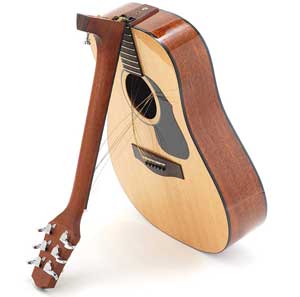
There are a few different style guitars in the Voyage-Air range, so check out this listing for more details.
Best Electric Travel Guitars
Even if you only play acoustic guitar, you may still prefer an electric travel guitar. These guitars are more compact than an acoustic and allow you to play in silence.
If you play electric guitar, check out this guide on How Much Electric Guitars Weigh to see how these travel guitars compare to a typical full-size electric guitar.
Traveler PRO MOD X Hybrid Acoustic-Electric
If you play both electric and acoustic guitar, the Traveler PRO MOD X might suit you. It has a piezo pickup for acoustic sounds and a humbucker for electric guitar sounds. It’s a full-scale guitar that is smaller than the above guitars (apart from the Voyage-Air when folded).
The Dual Rail Humbucker has a coil-split switch to allow you to change between a humbucker tone or single-coil tones. A separate switch allows you to change between the piezo and the magnetic pickups, or blend the two together. This gives you plenty of flexibility in tone.
The big difference between this guitar and the other options by Traveler is the shape of the body. The lap and armrests give you a more comfortable feel when playing the guitar seated. The rests are removable which is a nice way to further reduce the size if you need to.
Here are the main features of the Traveler PRO MOD X Hybrid (check out the price and availability here):
- Full-size electric guitar neck
- 28″ total length
- 24.75″ scale length
- 5.2″ wide (with the armrest removed and lap rest stowed) and 2″ deep
- 22 frets
- Dual-Rail Humbucker and Piezo pickups
- Hard Maple neck through body
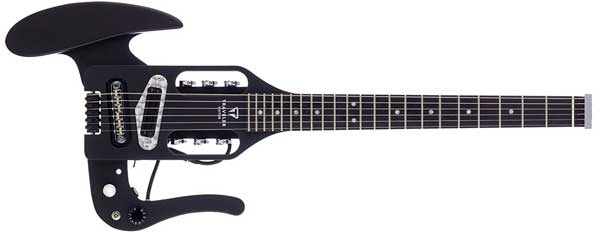
To get the most out of the above guitar, I recommend purchasing a VOX amPlug or iRig HD 2 as seen later on. I’ll explain later why you will want one of these options.
Traveler Guitar Ultra-Light Acoustic-Electric
The above guitar will suit most guitarists who want a silent and compact travel guitar. As an alternative, if you only play acoustic guitar, the Traveler Ultra-Light Acoustic-Electric might be a better option as it’s cheaper and focuses on only the essentials an acoustic guitarist would want. You still get a full-scale neck and compact design. The main difference is the acoustic bridge, the piezo, and the lack of an armrest.
The downside of this option compared to the acoustics from earlier is that they don’t look or feel like a ‘real’ acoustic guitar. Your arm won’t rest against a body and if you strum the strings without plugging headphones in you’ll hear a very soft tone. This could be a downside or an upside depending on your needs.
Here are the main features of the Traveler Ultra-Light Acoustic-Electric (check the price here):
- Full-size electric guitar neck
- 28″ total length
- 24.75″ scale length
- 5.2″ wide and 2″ deep
- 22 frets
- Dual-Rail Humbucker pickup
- Hard Maple neck through body

To get the most out of the above guitar, see the accessories below. I highly recommend getting something like the iRig HD 2 so you can jam along with backing tracks or use apps such as AmpliTube to get a better tone.
Travel Amps, Headphones and Accessories
These travel accessories help you get the most out of whatever guitar you bring with you.
Battery Powered Amps
If you will be traveling to places where you can plug into an amp and make some noise, you might want to check out the Battery Powered Mini-Amps here. You can plug headphones into them or use the inbuilt speaker to play at low or high volumes. Depending on the amp you get, you can access a variety of different tones and effects.

The above Yamaha is one of many choices you have for ultra-portable amps.
Vox amPlug
If you need to play in silence and only need a basic tone for your electric guitar, picking a suitable VOX amPlug is a good option. These small devices plug directly into the guitar and connect to your headphones. The amPlug simulated a guitar amp tone suitable for headphones. For example, the AC30 model is based on VOX’s AC30. There are quite a few models (AC30, Bass, Blues, Classic Rock, Clean, Lead, Metal) so check out the options here to find one that suits you.
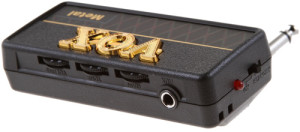
iRig HD 2
The VOX amPlug is fine if you only need a basic tone. But if you want more flexibility or want to jam along with music, a more suitable option is the iRig HD 2 which I review in full here. This option is only suitable if you have an iPhone/iPad/PC/Mac that you will take with you. Sadly it doesn’t offer Android support.
If you do have a compatible device, the iRig HD 2 allows you to access any relevant app such as AmpliTube (comes with the iRig), Garageband, BIAS FX, etc.
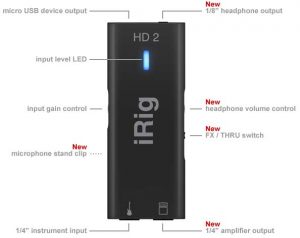
Noise Cancelling Headphones
If you’re a regular traveler, you probably already have a set of noise-canceling headphones. If not, they’re worth getting. While any headphones are perfectly fine when jamming in your hotel room, noise-canceling headphones make flights far more bearable. They filter out the constant noise during a flight which is fantastic when you want to try and sleep or relax.
Any of the wired noise-canceling headphones listed here should work fine. Higher-end headphones are usually more comfortable and produce better quality audio but even the cheaper models can produce good results.
A note on wireless headphones: If you’re looking at wireless headphones, there could be some latency that could potentially make it impossible to play guitar. Wireless headphones are fine for listening to music, but when you’re playing guitar you want as close to zero latency as possible so what you hear exactly matches what you’re playing. Higher-end models designed for gaming offer low latency, but I haven’t tried any to say whether it’s low enough for playing guitar.
Find out more about playing electric guitar with headphones here. The guide isn’t for travel but gives you a good idea of what to think about when you want to play electric guitar with headphones.
